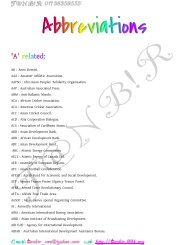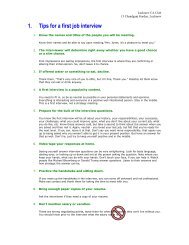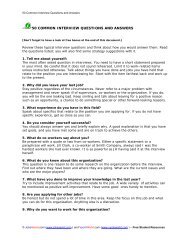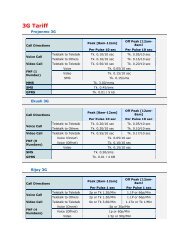What You Need to Know About 5S
You also want an ePaper? Increase the reach of your titles
YUMPU automatically turns print PDFs into web optimized ePapers that Google loves.
<strong>What</strong> <strong>You</strong> <strong>Need</strong> <strong>to</strong> <strong>Know</strong> <strong>About</strong> <strong>5S</strong><br />
The <strong>5S</strong>'s comes from 5 Japanese words that have been translated in<strong>to</strong> English. While the<br />
actual English translation may vary depending on who you are talking <strong>to</strong>, the meanings<br />
remain the same:<br />
Japanese Term<br />
Seiri<br />
Sei<strong>to</strong>n<br />
Seiso<br />
Seiketsu<br />
Shitsuke<br />
English Equivalent<br />
Sort<br />
Set In Order<br />
Shine<br />
Standardize<br />
Sustain<br />
<strong>What</strong> is <strong>5S</strong>?<br />
The <strong>5S</strong>'s - an English "translation"<br />
1. Sort: Clearing the work area<br />
2. Set in Order: Designating locations<br />
3. Shine: Cleanliness & workplace appearance<br />
4. Standardize: Everyone doing things the same way<br />
5. Sustain: Ingraining the <strong>5S</strong>'s in<strong>to</strong> the culture<br />
The <strong>5S</strong>'s lead <strong>to</strong> improved processes and ultimately:<br />
Reduced set-up times<br />
Reduced cycle times<br />
Increased floor space<br />
Lower safety incident/accident rate<br />
Less wasted labor<br />
Better equipment reliability<br />
Sort: Clearing the work area<br />
Any work area should only have the items needed <strong>to</strong> perform the work in the area. All other<br />
items should be cleared (sorted out) from the work area.<br />
Set in Order: Designating locations<br />
Everything in the work area should have a place and everything should be in its place.<br />
Shine: Cleanliness & workplace appearance<br />
Not only should the work area be clear, it should also be clean.<br />
Cleanliness involves housekeeping efforts, improving the appearance of the work area, and<br />
even more importantly, preventive housekeeping - keeping the work area from getting<br />
dirty, rather than just cleaning it up after it becomes dirty.<br />
1
Standardize: Everyone doing things the same way<br />
Everyone in the work area and in the organization must be involved in the <strong>5S</strong> effort,<br />
creating best practices and then getting everyone <strong>to</strong> "copy" those best practices the same<br />
way, everywhere, and every time. Work area layouts and s<strong>to</strong>rage techniques should be<br />
standardized wherever possible.<br />
Sustain: Ingraining the <strong>5S</strong>'s in<strong>to</strong> the culture<br />
It's <strong>to</strong>ugh <strong>to</strong> keep a <strong>5S</strong> effort, or any improvement effort for that matter, going. The <strong>5S</strong>'s<br />
involve a culture change. And <strong>to</strong> achieve a culture change, it has <strong>to</strong> be ingrained in<strong>to</strong> the<br />
organization - by everyone at all levels in the organization.<br />
<strong>What</strong> is Sort?<br />
Clearing the area means organizing the workplace so that it is a more effective,<br />
more efficient place <strong>to</strong> work.<br />
It involves sorting out what is not needed <strong>to</strong> perform the required work in the work<br />
area.<br />
If it's not needed, remove it.<br />
Use the 48-Hour Rule<br />
Instead of keeping things around that might get used someday, apply the 48-hour<br />
rule <strong>to</strong> everything in the work area.<br />
The 48-hour rule says: If it is not going <strong>to</strong> be used in the work area within 48 hours,<br />
it does not belong there.<br />
The steps used <strong>to</strong> identify what is and is not needed in a work area and then <strong>to</strong><br />
clear the work area of the unnecessary items are:<br />
Define what is needed.<br />
Define what is NOT needed.<br />
Disposition the items.<br />
Take action: Sort out (move out) what is not needed and move in what is needed<br />
(and is not there now).<br />
Define what is needed<br />
When considering what is needed in a work area, don't just look at the core<br />
equipment and <strong>to</strong>ols used. Consider the materials, supplies, and even the<br />
paperwork.<br />
This is also a good time <strong>to</strong> evaluate the proper quantities of items <strong>to</strong> keep in the<br />
work area.<br />
Defining what is needed in a work area is not something that can be done effectively<br />
by one person working alone; use a team representing all that work in the area.<br />
2
Define what is NOT needed<br />
After the team has identified what needs <strong>to</strong> be in the area, focus on all the other<br />
items currently in the work area.<br />
If an item is not needed <strong>to</strong> make the product, support the operation of the<br />
equipment, or for safety reasons, then it probably should not be kept in the direct<br />
work area.<br />
Disposition the items<br />
Take action<br />
Recap<br />
Once items that are not needed in the work area are identified, it's time <strong>to</strong><br />
disposition them and determine where they should be s<strong>to</strong>red.<br />
Tag items <strong>to</strong> be removed; use a standardized set of usage-based guidelines <strong>to</strong><br />
disposition items <strong>to</strong> be removed.<br />
Whenever possible, use data <strong>to</strong> determine the frequency of use, do not guess. The<br />
less frequently an item is used, the farther from the work area it should be s<strong>to</strong>red.<br />
Once items are dispositioned, it's time <strong>to</strong> take action <strong>to</strong> clear the work area and<br />
move tagged items <strong>to</strong> a temporary holding area.<br />
The holding area should be an accessible place where others not on the team can<br />
examine the items, confirm that they do not need <strong>to</strong> be kept in the work area, or<br />
discuss why they think an item is needed in the work area.<br />
The goal of the first of the <strong>5S</strong>'s, Sort, is <strong>to</strong> have only what is needed for the job in<br />
the work area.<br />
The Sort phase applies <strong>to</strong> all work areas, manufacturing departments, service<br />
processes, and offices.<br />
<strong>What</strong> is Set In Order?<br />
Set in Order or designating locations is about organization and orderliness. It<br />
means that there is a place for everything and everything must be in its place.<br />
Once the Sort phase has been conducted (deciding what should be in the work area<br />
and what should be removed from the direct work area), it's time <strong>to</strong> designate a<br />
specific location for everything.<br />
Using designated locations requires discipline and attention <strong>to</strong> detail from everyone<br />
in the work area.<br />
Designated locations save time and reduce both wasted effort and frustration.<br />
Having designated locations for everything needed in the work area enables<br />
employees <strong>to</strong> exert visual control over their operations. At a glance, employees are<br />
able <strong>to</strong> see if things are in-place or out-of-place and if more materials, supplies, or<br />
<strong>to</strong>ols need <strong>to</strong> be ordered.<br />
3
Effectively establishing designated locations requires knowledge of s<strong>to</strong>rage<br />
devices and options.<br />
On the surface, designating a location may seem like a simple and straightforward<br />
task, and sometimes it is. However, establishing effective "homes" for some items<br />
requires insight in<strong>to</strong> their use and knowledge of s<strong>to</strong>rage and identification options.<br />
A study of the location, type of s<strong>to</strong>rage, and labeling conventions is needed <strong>to</strong><br />
develop s<strong>to</strong>rage systems that help make the work area more effective and<br />
productive.<br />
Effective s<strong>to</strong>rage is based on a combination of fac<strong>to</strong>rs such as the frequency of<br />
use, the sequence of use, and the bulk or cubic feet occupied by the item s<strong>to</strong>red.<br />
There are numerous forms and types of s<strong>to</strong>rage arrangements. It's best <strong>to</strong> be<br />
familiar with the options so that you can select the best mode of s<strong>to</strong>rage for a<br />
particular item. Modes of s<strong>to</strong>rage include:<br />
The Floor<br />
Racks and Shelving<br />
Flow Racks<br />
Cabinets<br />
Carts<br />
S<strong>to</strong>rage Bins<br />
Portable Equipment<br />
Cus<strong>to</strong>m S<strong>to</strong>rage<br />
Central Cribs<br />
Shadow Boards<br />
Hanging Tools<br />
The use of signs and labels <strong>to</strong> identify "what is <strong>to</strong> be s<strong>to</strong>red where" helps<br />
employees use s<strong>to</strong>rage locations as they were intended <strong>to</strong> be used<br />
The information contained on the labels will be easier for all employees <strong>to</strong><br />
understand if the format for the labels is standardized.<br />
Where s<strong>to</strong>rage locations might change slightly, consider portable labels. For<br />
example, magnetic labels work extremely well on racking in s<strong>to</strong>rage and warehouse<br />
areas.<br />
For consumables, another alternative is <strong>to</strong> use kanban cards mounted in plastic<br />
sleeves as the labels. When the reorder quantity is reached, the kanban card can be<br />
removed from the sleeve and be used <strong>to</strong> reorder that item.<br />
<strong>What</strong> is Shine?<br />
The Shine phase is more than making the work area spic and span.<br />
There are three aspects of shine: getting the workplace clean, maintaining its<br />
appearance, and using preventive measures <strong>to</strong> keep it clean.<br />
4
Cleaning the workplace:<br />
Take the time <strong>to</strong> plan what needs <strong>to</strong> be cleaned, what it will be cleaned with, when it<br />
will be cleaned, and who will do the cleaning.<br />
Maintaining the appearance of the workplace:<br />
Techniques and practices that contribute <strong>to</strong> the appearance of a work area include:<br />
painting, lighting, dealing with clutter, dust collection, minimizing spills, and<br />
conducting routine maintenance.<br />
Using preventive measures <strong>to</strong> keep the workplace clean:<br />
Recap:<br />
Once the work area, <strong>to</strong>ols, and equipment are clean, they need <strong>to</strong> be kept that way.<br />
Continued housekeeping is one way <strong>to</strong> keep the work area, <strong>to</strong>ols, and equipment<br />
clean. But the better way is <strong>to</strong> prevent these from getting dirty in the first place.<br />
Root cause analysis, mistake-proofing, and the use of preventive measures are<br />
important <strong>to</strong> keep the workplace clean and orderly.<br />
Equipment that is kept clean performs more efficiently and has less unscheduled<br />
downtime. Additionally, many organizations find that productivity and safety<br />
performance improve as housekeeping improves.<br />
<strong>What</strong> is Standardize?<br />
Standardize, the fourth of the <strong>5S</strong>'s, involves putting the systems in place <strong>to</strong><br />
ensure that everyone does things the same way.<br />
The methodology for Sorting needs <strong>to</strong> be standardized, the approach <strong>to</strong> Set in Order<br />
needs <strong>to</strong> be standardized, and Shine especially needs <strong>to</strong> be standardized.<br />
In order <strong>to</strong> standardize:<br />
Roles and responsibilities must be clear and consistently applied.<br />
Training will be necessary <strong>to</strong> ensure all know how <strong>to</strong> apply <strong>5S</strong> techniques and "copy<br />
exactly," or apply them the same way.<br />
And, as with any improvement initiative, the effort must not be allowed <strong>to</strong> become<br />
static but must continuously evolve and grow.<br />
Roles and responsibilities:<br />
Roles in a <strong>5S</strong> effort are straightforward. Leaders must set the <strong>to</strong>ne and lead by<br />
example.<br />
Managers and supervisors must commit <strong>to</strong> the initiative, provide time for the<br />
workforce <strong>to</strong> develop and implement <strong>5S</strong> changes, provide guidance with those<br />
changes, and support the <strong>5S</strong> changes.<br />
5
<strong>5S</strong> training:<br />
Members of the workforce must embrace <strong>5S</strong> principles and practices and help<br />
implement the <strong>5S</strong>'s in their work areas.<br />
Universal indoctrination in general <strong>5S</strong> techniques is needed <strong>to</strong> help build a common<br />
<strong>5S</strong> vocabulary and skill base.<br />
As the <strong>5S</strong>'s are adopted work-area by work-area, each area will develop unique<br />
approaches and methods; anyone working in a specific work area must receive<br />
training in those work-area-specific methods.<br />
And, just like with any new skill, practice makes "perfect."<br />
Copy exactly:<br />
Standardization is about creating best practices and then getting everyone <strong>to</strong> "copy<br />
exactly," using the established best practices the same way, everywhere, and every<br />
time.<br />
Implementing a "copy exactly" mentality involves establishing standardized rules.<br />
Visual fac<strong>to</strong>ry techniques including color-coding, checklists, and labeling help<br />
reinforce a copy exactly approach.<br />
Continuous improvement:<br />
It works best when the approaches used <strong>to</strong> improve <strong>5S</strong> techniques and practices are<br />
standardized as well.<br />
For example, if an organization does use a common problem-solving process, time<br />
spent communicating new ideas and spreading lessons learned <strong>to</strong> other work areas<br />
will be saved.<br />
<strong>What</strong> is Sustain?<br />
Sustain is perhaps the most difficult phase of the <strong>5S</strong>'s.<br />
<strong>You</strong> would think that after going through the trouble of Sorting, Setting in Order,<br />
Shining, and Standardizing that the fifth S, Sustain, would be easy.<br />
But, unfortunately, Sustain is perhaps the <strong>to</strong>ughest of the <strong>5S</strong>'s.<br />
Communication is necessary <strong>to</strong> reinforce the <strong>5S</strong>'s.<br />
Sustaining requires keeping everyone involved, continually reinforcing what and why<br />
the <strong>5S</strong>'s are important.<br />
Communication becomes the spotlight for a <strong>5S</strong> initiative. Keep reinforcing the<br />
message and emphasizing roles and responsibilities.<br />
Sustaining the <strong>5S</strong>'s requires leadership, commitment, and allocation of the time and<br />
resources necessary <strong>to</strong> keep the effort vital.<br />
Recognition for jobs done well becomes the fuel that keeps the effort dynamic.<br />
6
Preventing backsliding:<br />
Audits can serve as on-going checks on <strong>5S</strong> activities.<br />
A teamwork approach builds a common effort <strong>to</strong>ward achieving a common goal.<br />
Soliciting ideas for improvement will generate ideas <strong>to</strong> improve and help sustain the<br />
<strong>5S</strong> effort.<br />
And reacting immediately <strong>to</strong> problems is a must or the organization can quickly slide<br />
back <strong>to</strong> old habits.<br />
Sustaining the <strong>5S</strong> effort takes a lot of work. It takes commitment and involvement<br />
by everyone <strong>to</strong> keep the effort going and <strong>to</strong> prevent the organization from just<br />
sliding back in<strong>to</strong> the old ways of doing things.<br />
Implementing <strong>5S</strong><br />
Step 1: Start with the Leadership Team<br />
As with any improvement effort, implementation of the <strong>5S</strong>'s must be driven from the<br />
<strong>to</strong>p of the organization.<br />
Only Top Management can create the environment needed and give the effort the<br />
visibility and importance it needs for long term viability.<br />
Step 2: Build the Infrastructure<br />
The <strong>5S</strong> effort should fit within an organization's existing improvement structure.<br />
Divide & conquer by establishing <strong>5S</strong> subcommittees for Communications, Training,<br />
Project Support, and Best Practices.<br />
Step 3: Launch Communications<br />
Conduct short, focused, and frequent communication sessions with all employees on<br />
the what, why, how, when, and who of the <strong>5S</strong> initiative.<br />
Deliver the message in several formats including group meetings, using the<br />
organizations' intranet or website, bulletin board postings, and internal newsletters.<br />
Step 4: Train Teams in <strong>5S</strong> Techniques<br />
Develop a plan <strong>to</strong> train everyone in basic <strong>5S</strong> concepts and then supplement the<br />
generic training with just-in-time training in work-area-specific practices.<br />
Note that the initial teams may need <strong>to</strong> be trained in problem-solving techniques and<br />
root cause analysis.<br />
Additionally, there may be a need <strong>to</strong> provide training for the leadership team in<br />
communication skills, recognition strategies, and facilitation skills.<br />
Step 5: Begin <strong>5S</strong> Pilots<br />
Select areas that need the <strong>5S</strong>'s (and that you project will be successful in adopting<br />
<strong>5S</strong> practices) as pilot areas. <strong>What</strong> is learned in the pilot areas will be used <strong>to</strong> help<br />
develop a full roll-out plan.<br />
7
The first pilot work areas <strong>to</strong> receive <strong>5S</strong> treatment should be ones with high visibility.<br />
For example, select work areas in which nobody wants <strong>to</strong> work because they are so<br />
congested or dirty.<br />
Step 6: Establish Best Practices<br />
Creation (and use) of a Best Practices Database can help multiply the impact of <strong>5S</strong><br />
successes by providing the means <strong>to</strong> share successes throughout the organization.<br />
Step 7: Develop a Full Roll-Out Plan<br />
After completing the initial pilots and before involving the rest of the organization in<br />
the <strong>5S</strong> effort, step back and evaluate how the pilots went.<br />
Get ideas from members of the pilots about how <strong>to</strong> strengthen the <strong>5S</strong> process and<br />
use those ideas <strong>to</strong> develop a roll-out plan.<br />
A comprehensive roll-out plan defines the sequence of events, establishes roles,<br />
responsibilities, and performance measures.<br />
Step 8: Continually Evaluate & Adjust<br />
As with any process, as lessons are learned, make improvements <strong>to</strong> the <strong>5S</strong> effort.<br />
Modify and strengthen the infrastructure, select new <strong>to</strong>ols <strong>to</strong> add <strong>to</strong> the "arsenal,"<br />
develop improved methods <strong>to</strong> measure and communicate progress, and challenge<br />
work areas <strong>to</strong> constantly improve.<br />
8












